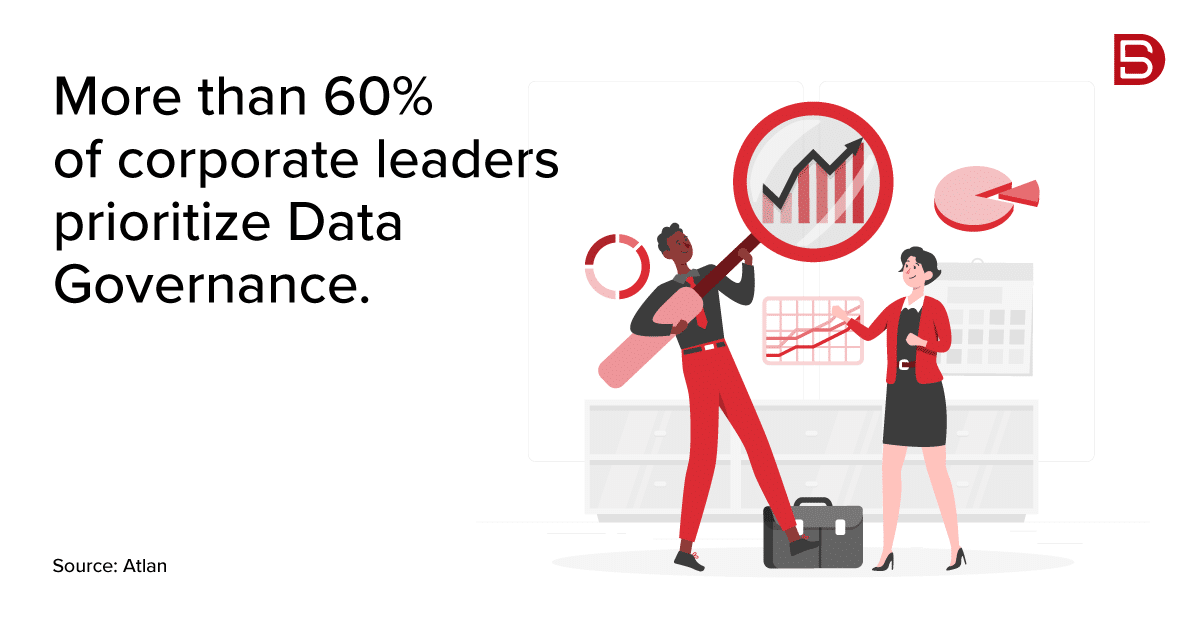Relying on shaky and unreliable information for critical business decisions is the Achilles’ heel of many organizations struggling with poor data quality and management. Inconsistent data acts like a house of cards – one wrong piece, and the whole thing crumbles. This is where data governance plays a crucial role. It’s a powerful framework for ensuring the accuracy, security, and accessibility of your data.
The good news? You don’t have to reinvent the wheel. By learning from established best practices and adopting an agile approach, you can implement data governance effectively in your organization.
In this blog, we’ll explore these best practices and show you how to get started with it. But first, let’s dive deeper into what data governance is and how it can benefit your organization.
What is a Data Governance Framework?
A data governance framework is a collaborative model for managing enterprise data. It is a set of guidelines (sometimes flexible, sometimes strict) that dictate how data is created and handled. To make sure everything runs smoothly, companies often put together a data governance team. This team oversees making sure data is used properly, stays high-quality, and complies with policies. Implementing a data governance framework touches every part of your data management process, from architecture to analytics to data models. When done right, it makes it easier to make smarter decisions, faster.
Once you grasp the fundamentals of data governance and its potential impact on your organization, start exploring templates, models, and best practices available on the market. You can find these best practices in software tools, frameworks, libraries, or through consultants. While every organization is unique, there are basic best practices to help guide you when you’re ready to move forward.
6 Essential (& Effective) Data Governance Best Practices
1. Think Big, Start Small
Data governance involves people, processes, and technology. To get the big picture right, start with the people, then build your processes, and finally bring in the technology. Without the right people, it’s tough to create the processes needed for successful tech implementation. Find or hire the right folks first; they’ll help shape your processes and pick the best technology to get the job done right.
2. Make Your Case
Getting buy-in and support from leaders is essential for establishing a data governance practice but buy-in alone isn’t enough for success. Build a compelling business case by highlighting the benefits and opportunities that better data quality will bring to the organization. Show how it can boost revenue, improve customer experience, and enhance efficiency. Help everyone understand both the effort required and the long-term benefits. While most leaders recognize that poor data quality and management are problems, your data governance plans might fall short if leadership isn’t committed to making changes.
3. Measuring What Counts
Like any goal, if you can’t measure it, you can’t achieve it. Before making any changes, establish a baseline to justify the results afterward. Collect these initial measurements early and consistently track progress at every step. Your metrics should reflect overall changes over time and act as checkpoints to ensure your processes are practical and effective.
4. Keep Everyone in the Loop
No matter where your organization stands with its data governance efforts, keeping up the communication is essential. Share the wins, tackle the setbacks head-on, and ensure everyone knows their role. Keep an updated list of stakeholders, and make sure your updates are clear and easy to digest. This way, everyone stays in the know, we celebrate victories together, and we navigate challenges as a team.
5. Embrace the Data Governance Journey
Data governance isn’t a sprint with a clear finish line; it’s more like a marathon. It’s not about launching a project and hoping for the best. Instead, approach it as a long-term investment rather than a one-time effort. While flashy project launches can grab attention, true data governance is an ongoing, iterative process. It involves numerous sub-projects and milestones that build upon each other.
Start with small pilots to gather insights and gradually integrate these lessons into broader initiatives across your organization. While data governance programs can span years, individual projects typically shouldn’t exceed three months. Integrate smaller projects into your long-term strategy to drive meaningful and lasting change throughout your organization.
6. Define Team Roles & Responsibilities
Successful data governance hinges on collaboration across departments. Clearly outlining roles is crucial for any data governance initiative, ensuring accountability throughout your organization. By assigning ownership levels, you can effectively introduce and organize your data governance program, creating a unified approach to managing data challenges. While specific roles may vary, typical ones include:
- Data Governance Council (Strategic Level): The data governance council guides the overall strategy of the data governance program. They prioritize projects, set initiatives, and approve organization-wide data policies and standards.
- Data Governance Board (Tactical Level): The data governance board develops policies and practices to treat data as a valuable strategic asset within the organization.
- Data Managers: Data managers create and maintain database systems that meet the organization’s data needs.
- Data Owners: Data owners take responsibility for specific data assets within the organization, ensuring they are managed effectively.
- Data Stewards: Data stewards use data governance processes to maintain the quality of data elements, including both content and metadata.
- Data Users: Data users are team members who directly handle and utilize data as part of their daily work. They access and analyze integrated datasets at a detailed level for tasks like statistical analysis and research.
Ultimately, data governance revolves around people, processes, and technology. A successful program ensures a clear understanding of data origins and ownership. It establishes reliable processes for managing data updates and changes. It’s crucial to recognize the value of the individuals overseeing these processes and working with technology.
Taking Control of Your Data: A Clear Path to Success
Poor data quality can cripple an organization’s ability to make informed decisions. Data governance offers a structured approach to ensure data accuracy, security, and accessibility. Here’s the key takeaway: a successful data governance program hinges on three pillars: people, processes, and technology.
That said, data governance is an ongoing investment, not a one-time project. Start small, learn from pilot programs, and gradually integrate these learnings into broader initiatives across the organization. By focusing on these data governance best practices, you can empower your organization to make smarter, data-driven decisions.
Ready to take control of your data and unlock its full potential? Contact us at marketing@datamaticsbpm.com and we can help you craft a customized plan to achieve your specific goals.
 Select an element to maximize. Press ESC to cancel.
Select an element to maximize. Press ESC to cancel.
Henry Romano



